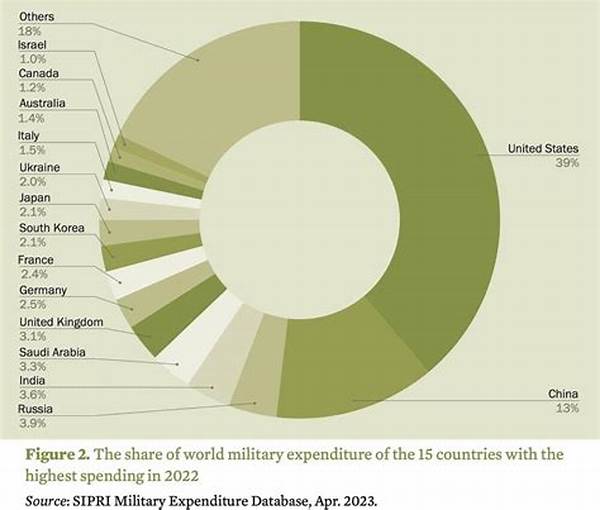The study of global military budgets reveals a landscape deeply influenced by geopolitical tensions, economic capacities, and evolving security paradigms. The allocation of financial resources by states for military purposes not only reflects their strategic priorities but also underscores the balance of power in international relations. This analysis of global military budgets provides critical insights into how nations prioritize defense spending in relation to other competing needs within their economies, offering a lens through which one can assess the global security architecture and its shifting dynamics.
Factors Influencing Military Budgets
The analysis of global military budgets begins with an understanding of the factors that influence defense spending. Primarily, the geopolitical context plays a decisive role, as nations respond to perceived threats and regional power dynamics. Economic capacity is another critical element; wealthier nations typically allocate more substantial sums to their military apparatus. Technological advancements also necessitate higher expenditures, as modern warfare demands significant investments in cutting-edge technology. Additionally, historical commitments and obligations, such as international alliances and defense treaties, significantly impact a country’s defense budget. Public opinion, though often less quantifiable, can influence government priorities, leading to fluctuations in military spending based on domestic political landscapes.
In the modern era, the analysis of global military budgets must also consider the increasing significance of cybersecurity and space defense. As nations develop capabilities in these domains, new funding allocations emerge, reflecting the changing nature of warfare. Furthermore, fluctuating economic conditions and unexpected global events, such as pandemics or financial crises, can influence the allocation of resources, necessitating adjustments in budgetary priorities. Through this multifaceted lens, the analysis of global military budgets uncovers the complexities and intricacies of defense spending in the 21st century.
Key Components of Military Expenditure
1. Personnel Costs: Personnel costs often constitute a significant portion of a military budget. The analysis of global military budgets indicates that salaries, benefits, and pensions for military personnel require substantial financial allocations.
2. Procurement and Equipment: The acquisition of new weapons systems and equipment is a critical component. The analysis of global military budgets reveals that investments in advanced technology are paramount to maintaining competitive military capabilities.
3. Operations and Maintenance: Funds are also allocated for the upkeep of existing assets. The analysis of global military budgets highlights the importance of maintaining operational readiness through regular maintenance and training.
4. Research and Development: R&D is essential for innovation in defense technology. The analysis of global military budgets emphasizes the need for continual advancements to address emerging threats through substantial research investments.
5. Infrastructure: The development and maintenance of military bases and facilities require significant funding. The analysis of global military budgets shows that infrastructure is vital for supporting military operations and training.
Regional Disparities in Defense Spending
The analysis of global military budgets also highlights significant disparities in defense spending across different regions. For instance, North America, particularly the United States, consistently dominates global defense expenditures, reflecting its geopolitical influence and military commitments worldwide. In contrast, regions such as Africa and South America allocate comparatively less to military purposes, often focusing on socio-economic development priorities. Europe’s defense budgets display variance, with some countries adhering to NATO guidelines while others prioritize regional stability. Similarly, Asia’s growing economies, such as China and India, have seen consistent increases in defense spending, reflecting their expanding roles on the world stage.
This regional analysis underscores the diverse security needs and priorities of various nations. Countries in volatile regions may allocate a higher percentage of their GDP to defense for security assurances. In contrast, those in more stable environments might opt for a more modest approach, directing funds to other sectors. Consequently, this analysis of global military budgets highlights the complexity of global defense economics and the influence of both internal and external factors on budgetary decisions.
Implications of Military Spending
Military spending decisions carry profound implications for both national and international landscapes. Analysis of global military budgets reveals that excessive defense spending can strain national economies, diverting resources from essential services such as healthcare and education. Conversely, inadequate military funding may leave a nation vulnerable to external threats, underscoring the delicate balance countries must maintain.
Additionally, analysis of global military budgets demonstrates how defense expenditures impact international relations. High military budgets may provoke regional arms races, increasing tensions among neighboring states. Alternatively, they could serve as deterrents, preserving peace through strength. Furthermore, these budgets often reflect a nation’s priorities on the global stage, influencing its relationships with allies and adversaries alike. The strategic choices made in resource allocation for defense purposes thus play a crucial role in shaping a country’s diplomatic and security strategies.
Future Trends in Military Expenditure
The future of military spending will be shaped by several emerging trends. The analysis of global military budgets indicates a growing focus on cyber capabilities and digital warfare, prompting shifts in funding from traditional land, sea, and air forces to these new domains. Similarly, the development of autonomous weapons systems and artificial intelligence in defense brings about both opportunities and ethical concerns, reshaping budgetary allocations.
Another trend that the analysis of global military budgets highlights is the increasing role of private defense contractors and partnerships. As militaries seek to harness the latest innovations swiftly, collaboration with private sector entities becomes vital. Finally, global challenges such as climate change may redefine security priorities, pushing nations to consider environmental factors in defense strategies. Consequently, analysis of global military budgets will need to adapt to these evolving paradigms, ensuring a comprehensive understanding of global defense economics in the years to come.
Conclusion
In summary, the analysis of global military budgets provides a comprehensive understanding of the complexities and intricacies of defense spending worldwide. These budgets are driven by a myriad of factors, including geopolitical dynamics, economic capacity, and technological advancements. Through a detailed examination, one can discern the multifaceted nature of military expenditures and their implications on global security and international relations.
Ultimately, the analysis of global military budgets underscores the delicate balance that nations must strike between maintaining adequate defense capabilities and addressing other critical socioeconomic needs. As the global landscape continues to evolve, so too must the approach to understanding and managing military spending, ensuring that it effectively contributes to the overarching goals of peace and security.





